2.1 专利申请量及授权量年度趋势
图1为磷酸钙骨水泥的全球申请及授权趋势变化图,从1983年首个专利申请起,磷酸钙骨水泥的全球申请量逐步上升,2001年达到峰值,后逐步下降,2013、2014、2015、2016年申请量下降较快,说明该领域技术已进入成熟期,这与产业情况(已有多个产品上市)基本相符。从授权趋势看,2013年为授权高峰期,近5年还有较多的专利获得授权。
图2显示专利申请量与专利权人数量对应图,可见近年申请量和申请人双跌,也表明领域虽仍有较为活跃的专利申请,但技术成熟度已较高。
图3为排名前3位的国家磷酸钙骨水泥专利申请量年度趋势图,从年度申请趋势看,日本研发较早,从1986年开始即有较多专利申请,持续到2007年仍有年申请20余件;美国虽然是技术起源国,但其基础专利US4518430仅在美国布局,专利申请量明显上升也是从2001年才开始;中国2001年后申请量开始上升,2010年后处于较高数量,超过美国和日本。排名第四位到第八位的国家或组织分别为世界知识产权组织、欧洲专利局、澳大利亚、加拿大、德国,其中后3个国家自2008年起专利申请量均在10件以下。


2.2 专利申请人归属地及专利申请公布地分布 专利申请的国别归属地反映了技术的来源国情况,从国别归属地分布来看,该领域约26%的专利申请都来自美国,反映出美国公司在医疗行业强大的研发实力,在磷酸钙骨水泥领域处于领先地位的埃特克斯、强生表现非常抢眼,见
图4。位于其后的是日本,拥有三菱等磷酸钙骨水泥研发实力强大的机构。中国近年也涌现了一批以上海纳米技术及应用国家工程研究中心有限公司、华东理工大学、华南理工大学为代表的磷酸钙骨水泥研究机构,主要集中在高校;法国拥有南特大学和法国国家科学研究中心等研究机构和GRAFTYS公司,在磷酸钙骨水泥领域的研发实力不容忽视。

专利申请的实际公布国家反映了专利布局的地域,从实际公布地分布来看,除了世界知识产权组织及欧洲专利局这种申请途径选择以外,美国、日本、中国、澳大利亚、加拿大、德国都是专利布局重要国家,专利申请的布局量均达100件以上,其次韩国、西班牙、奥地利也较多,见
图5。经进一步统计,中国公布的307件专利中,来自国外的申请量为85件,中国大陆申请量为215件,中国台湾地区申请量为7件。

2.3 专利申请人分析
图6是全球磷酸钙骨水泥领域中专利申请量前9位的申请人统计图,专利申请数量100件及以上的机构有美国强生、美国埃特克斯、法国国家科学研究中心和日本三菱。中国企业及研究机构的专利数量尚未进入前9名。
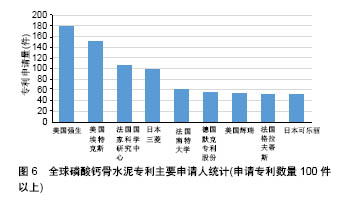 图7
图7显示排名前3位国家美国、日本、中国的专利申请人的类别分布,可以看出美国、日本以企业为主,中国以高等院校及研究机构为主,其中中国专利的公司申请量中,中国本土公司仅申请51件,占全部中国专利量的16.6%,说明中国本土公司的研发活跃度有待提升。

2.4 法律状态分析 如
图8所示,2 711件专利中,目前授权有效的数量为961件(占35%),申请中的数量为234件(占9%),两者相加的总占比为44%;专利撤回率比较低,说明该领域专利技术授权率较高;有近一半的专利放弃及过期。总体而言,该领域虽仍存在较为密集的专利障碍,但由于放弃及过期量也较大,早期的一些专利技术已进入公有领域。

2.5 技术功效分析 技术功效矩阵是微观分析中常用的分析方法,通过阅读专利,将相关专利归入技术和功能效果分类中,实现对专利的重新分类,并分析技术空白点。纵轴与横轴的交叉点表示相应技术实现对应的功能效果。图中球形面积越大代表该交叉点专利越多,说明该交叉点是行业对该领域进行专利布局的重点区域,专利保护相对完善。交叉点球形面积较小的区域可看作专利布局的空白区域,除不可实现的部分外(技术手段无法实现相应的功能效果),其他部分则属于领域内的技术空白。
图9为磷酸钙骨水泥专利的技术功效矩阵图,该图是通过人工阅读2 711件专利标引,取密切相关的1 110个专利制作而得。图中纵轴表示技术点,主要包括无改性、无机盐参与改性、聚合物参与改性、生物活性因子或载药参与改性、氧化物参与改性、其他有机物参与改性及其他无机物参与改性;横轴表示实现的功能效果,包括生物活性、生物相容性,机械性能、固化性能、降解性能和显影性能改善。其中“生物活性”主要是指在植入物周围可诱导硬组织形成,即具有骨诱导作用;“生物相容性”是指在接受者体内不产生不可接受的或不良的生理响应、免疫响应;“降解”是指材料在体内能够被再吸收。由图9可看出,无机盐、聚合物、生物活性因子或载药参与改性的专利较多,其中无机盐、聚合物改性主要覆盖机械性能、固化性能和降解性能改进,少量也显示对生物活性和生物相容性的促进;生物活性因子或载药改性主要覆盖生物活性、生物相容性;氧化物参与改性,主要涉及了晶须等物质,可改善磷酸钙骨水泥的固化时间、机械性能等;其他有机物主要为小分子有机酸及其盐、含碘的有机物等,主要改善固化性能、机械性能、显影性能等。表2显示专利申请文件中披露的主要改性物质。

进一步分析可知,在改性磷酸钙骨水泥中,以磷酸钙盐为基础,改性组分的方式包括单一组分、两组分、三组分、四组分、五组分及六组分,大部分集中在单一组分改性、复合两组分改性和复合三组分改性方面。以复合两组分为例,包括:无机盐+聚合物、无机盐+生物活性因子或载药、无机盐+氧化物、无机盐+其他有机物、无机盐+其他无机物、聚合物+生物活性因子或载药、聚合物+氧化物、聚合物+其他有机物、聚合物+其他无机物、生物活性因子或载药+其他有机物、氧化物+其他有机物、氧化物+其他无机物及其他有机物+其他无机物共13种复合方式,
图10显示了复合两组分改性中各种组合的专利家族数量对比情况。

2.6 重点公司专利布局分析
2.6.1 强生公司 强生公司旗下子公司DePuy Synthes提供的磷酸钙骨水泥产品包括Norian
® SRS、Norian® CRS、Norian Drillable和ChronOS
TM Inject等,其中注射式自固化磷酸钙骨水泥Norian
® SRS 1995年投入市场。
图11为强生相关专利申请年度统计,到2013年仍有较高的申请量,说明该公司即使已有较为成熟的产品推出,但仍在持续进行研发。
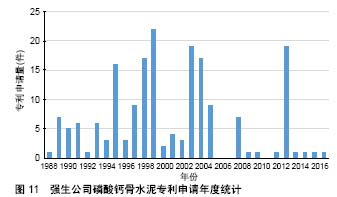 图12
图12为强生磷酸钙骨水泥专利申请地域分布状况,强生除了在本国进行布局外,非常重视专利全球布局,涉及到近20个国家、组织或地区,重点布局的国家有日本、加拿大、德国、澳大利亚、奥地利、中国。有4个国家仅布局了一件专利,未在此图中显示。

强生公司的技术重点关注无机盐改性、聚合物改性,对生物活性因子及载药、氧化物改性、其他有机物改性、其他无机物改性也有涉猎。进一步地,强生公司磷酸钙骨水泥改性包括单一组分改性、两组分复合改性、三组分复合改性、四组分复合改性、五组分复合改性和六组分复合改性。较多的改性组配为:无机盐、无机盐+聚合物、无机盐+生物活性因子或载药、无机盐+聚合物+生物活性因子或载药、无机盐+聚合物+生物活性因子或载药+氧化物+其他有机物+其他无机物。
2.6.2 埃特克斯公司(ETEX) ETEX公司从事开发、制造和商业化磷酸钙生物材料。Alpha-bsm®是ETEX公司基于无定形磷酸钙的第一代可注射和可成型的商品化磷酸钙水泥,该公司还拥有Beta-bsmTM和Gamma-bsmTM商品化磷酸钙骨水泥。图13为ETEX公司磷酸钙骨水泥专利申请年度统计,2009年前申请量较高,近年已很少申请专利。

ETEX公司的技术在改性材料方面覆盖全部6个类别,无机盐、生物活性因子或载药及聚合物参与改性的研究最多。进一步地,ETEX公司磷酸钙骨水泥改性分为单一组分改性、两组分复合改性、三组分复合改性、四组分复合改性和五组分复合改性,其中三种组分复合改性和四种组分复合改性成果占了59%。较多的改性组配为:无机盐+聚合物+生物活性因子或载药+其他有机物、无机盐+聚合物+生物活性因子或载药+氧化物+其他有机物、无机盐+聚合物+生物活性因子或载药。
2.6.3 法国国家科学研究中心 法国国家科研中心(CNRS)是法国最大的科学技术研究机构,图15为国家科学研究中心磷酸钙骨水泥专利申请年度统计,近年来专利申请量明显下降。该中心的很多相关专利与南特大学及格拉夫蒂斯公司(GRAFTYS)联合申请。GRAFTYS公司有相应商品上市。
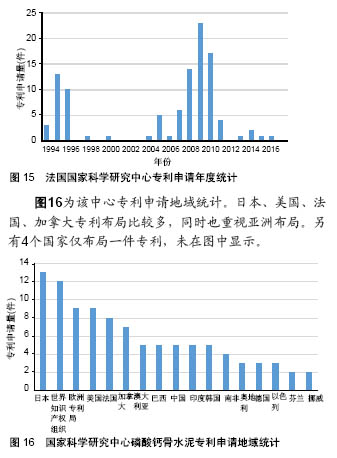
法国国家科学研究中心的研发相对有侧重点,改性材料覆盖了4个类别,无机盐改性、聚合物改性、生物活性因子或载药改性及其他有机物改性,其中无机盐及聚合物参与改性的研究较多。在改性组配方面,分为单一组分改性、两组分复合改性、三组分复合改性及四组分复合改性,以单一组分改性和两组分复合改性为主,较多的改性组配为:无机盐、无机盐+聚合物、无机盐+聚合物+生物活性因子或载药。
2.6.4 日本三菱公司(MITSUBISHI) 日本三菱公司材料综合研究所对磷酸钙骨水泥进行了一系列研究与改进,开发了Biopex,后经改进研发出新一代商品化磷酸钙骨水泥BiopexR,由日本三菱公司生产。图17为三菱磷酸钙骨水泥专利申请年度统计,三菱对磷酸钙骨水泥的研发起步较早,1991、2001年专利申请数量比较多,2003年后已无专利申请
 图18
图18为三菱公司磷酸钙骨水泥专利申请地域统计,可看出三菱申请的专利主要在本国布局,澳大利亚、中国台湾、德国、法国、英国、美国、中国香港等国家、组织及地区有少量布局,未在中国大陆布局。

三菱公司的研发主要覆盖了无机盐改性,关注机械性能的提高,聚合物改性、生物活性因子或载药改性及其他有机物改性均较少。
2.6.5 代表性公司埃特克斯专利技术演进图 埃特克斯公司在磷酸钙骨水泥改进过程中的重点专利技术演进,见图19所示,可看出除了材料组分改进外,复合生物活性因子及载药是其重点方向,近年来对致孔和硬度增强改性关注较多。
2.7 中国专利状况分析 全球2 711件筛选出的专利申请中,包含307件中国专利申请,其中100件授权有效,99件审查中,108件失效。
2.7.1 域外申请人在华专利分析 表3显示307件中国专利申请的申请人归属地,其中约68%的申请人为中国申请人(包含来自的台湾申请7件),美国、法国次之。来自外国的专利一共85件,占28%。
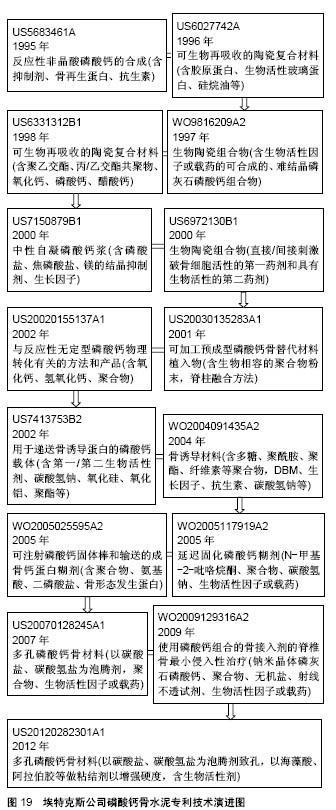
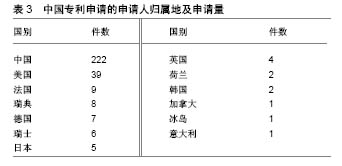 图20
图20对磷酸钙骨水泥的域外申请人在华专利进行排名,强生公司布局量相对高,达到9件,但与其在其他国家布局比较来看数量偏少;埃特克斯布局6件,也不算高。另外,2位个人申请人目前为中国台湾成功大学研究人员。总体而言,中国不是外国公司磷酸钙骨水泥的主要布局国,但核心专利在中国还是有一定量的布局,授权专利维持年限较长,多个专利已维持10年以上。
2.7.2 中国本土申请人分析 图21显示磷酸钙骨水泥的本土申请量排名前8位的申请人情况,其中上海纳米技术及应用国家工程研究中心有限公司申请量排名第一,但华南理工大学、华东理工大学授权量及维持有效量分列第一、第二。其中华东理工大学相关技术通过许可等方式落地于上海瑞邦生物材料有限公司[19],瑞邦公司的骨泰类产品已获得药监批号,产品相对成熟。
2.7.3 专利风险预警 对于磷酸钙骨水泥领域的中国本土产品研发、制造、销售者而言,磷酸钙的基础核心专利已过期,专利风险主要是来自改进型专利的国内外专利权人,目前有效及在审专利(合并称为活跃专利)的申请人-技术气泡图,见图22。无机盐改性、聚合物改性、生物活性因子或载药改性关注较多。

有效专利的权利要求包括2类:①产品权利要求,通过添加不同种类的材料对磷酸钙骨水泥进行改进,组分上注重不同种类材料组配,改善磷酸钙骨水泥的生物活性、生物相容性、机械性能、固化性能、降解性能或显影性能;②方法权利要求,主要为制备各种改性磷酸骨水泥的方法。其中,强生、埃特克斯、国家科学研究中心、三菱、南特大学、辉瑞、默克专利股份公司、格拉夫蒂斯公司、可乐丽、好梅迪卡整形器械公司、卡西特股份、骨维护、美敦力等公司的专利权利范围相对较大,本土企业应注意侵权风险防范,后期研发中也应有意识进行规避。中国本土产品若向国外进行销售,则需注意国外专利分析,以提前做好应对措施。
表4为筛选出的在中国仍有效的重要授权专利清单。重要性重点考虑权利要求保护的范围,并参考专利族中专利数、授权后维持的时间选取得到。由于权利要求文字较多不便在文中列出,此表仅提炼相关技术点以供参考。
限于篇幅,文章选择上述专利中维持年限超过10年、权利要求范围相对较大或存在商业化产品的5项专利进行权利要求分析:①惠氏公司与埃特克斯公司共同所有的专利“用于骨诱导蛋白的磷酸钙传递载体”(CN101239182B),申请日为2002-06-06,已维持16年,由于惠氏公司被辉瑞公司收购,该专利也属于辉瑞公司,其INPADOC专利家族数共51个,在美国、日本、澳大利亚、加拿大、中国、巴西、韩国、匈牙利、中国台湾、以色列、挪威、南非、墨西哥、波兰均获得授权并维持有效。在中国维持有效的上述专利独立权利要求为“一种用于治疗哺乳动物骨缺损的组合物,它包含作为第一种生物活性作用剂的骨形态发生蛋白,作为载体的磷酸钙材料,以及有效用量的泡腾剂”。该权利要求采用“包含”式开放式撰写,权利要求范围较大。该专利在中国还有1个授权的同族专利(CN100379424C)。针对该专利,省略泡腾剂不构成侵权;②上海瑞邦生物材料有限公司的“自固化磷酸钙原位成骨活性骨水泥及其制备方法和应用”专利(CN1302822C),申请日为2002-11-28,已维持16年,为瑞邦公司的核心专利,未在国外布局。其授权的独立权利要求为:“一种自固化磷酸钙原位成骨活性骨水泥,其特征在于由磷酸钙骨水泥与治疗有效量的复合生物活性因子包涵体或生物活性因子冻干品组成;质量比如下:磷酸钙骨水泥∶复合因子包涵体或生物活性因子冻干品=1 000∶(0.1-150)”。该权利要求采用了“由……组成”的封闭式撰写方式,权利要求范围相对较小,易于规避。瑞邦公司商业化上市产品“自固化骨水泥磷酸钙人工骨”(国械注准20163462169),包含活性因子重组人骨形态发生蛋白2,同时受上述专利及后续专利“长链型重组人骨形态发生蛋白2及其制备方法和应用”(CN1951964B )保护;③罗伯特•马泰斯•斯蒂夫腾和辛迪思有限公司共同所有的“骨修复材料”专利(CN101309708B),申请日为2005-11-05,已维持13年,该专利为强生公司核心专利,其INPADOC专利家族数共16个,在美国、日本、澳大利亚、加拿大、中国、德国、奥地利均获得授权并维持有效。在中国维持有效的上述专利独立权利要求为:“一种骨修复材料,包含:具有大于20 μm直径的第一颗粒状组分,选自磷酸钙、焦磷酸钙或硫酸钙二水合物;选自贫钙羟磷灰石、羟磷灰石或氟磷灰石的具有小于1 μm粒子直径的第二组分;包含水或水溶液的第三组分;由此第二和第三组分的体积分数代表总骨修复材料的至少35%;第三和第一组分之间的体积比在2.7-3.8之间”。权利要求中技术特征限定较多,权利要求范围不是很大,较为容易规避;④豪迈帝凯奥斯泰纳克公司的“磷酸钙水泥”专利(CN101264338B),申请日为2006-04-07,已维持12年,其INPADOC专利家族数共19个,在美国、日本、澳大利亚、加拿大、中国、奥地利、西班牙均获得授权并维持有效。在中国维持有效的上述专利独立权利要求为“一种磷酸钙水泥,它包含: 第一粉末组分,包含稳定二水合磷酸二钙,所述二水合磷酸二钙含10-60 ppm镁;第二粉末组分,包含除所述稳定的二水合磷酸二钙外的至少一种其它磷酸钙矿物;第三液体组分,包含水”。该权利要求采用“包含”式开放式撰写,权利要求范围较大。该专利在中国还有1个授权的同族专利(CN100460021C)。该专利的核心在于二水合磷酸二钙中含10-60 ppm镁,规避时注意该特征即可;⑤格拉夫蒂斯公司和南特大学共同所有的“大孔性和高吸收性磷灰石型磷酸钙粘固粉”专利(CN101636185B),申请日为2007-08-23,已维持11年,其INPADOC专利家族数共23个,在美国、日本、澳大利亚、加拿大、中国、韩国、以色列、南非、俄罗斯、印度、西班牙、葡萄牙均获得授权并维持有效。在中国维持有效的上述专利独立权利要求为“可用作骨黏固粉的黏固粉粉末,其包括有机组分和无机组分,有机组分由一种或多种生物相容性和生物再吸收性聚合物组成,无机组分由一种或多种钙的磷酸盐化合物组成,其中所述生物相容性和生物再吸收性聚合物选自多糖及其盐,且呈微粒子形式,其中所述骨黏固剂包括至少70%的α-磷酸三钙”。该权利要求采用“包括”式开放式撰写,权利要求范围较大。该专利的核心在于生物相容性和生物再吸收性聚合物选自多糖及其盐,且呈微粒子形式,规避时注意该特征即可。

.jpg)



















.jpg)
.jpg)